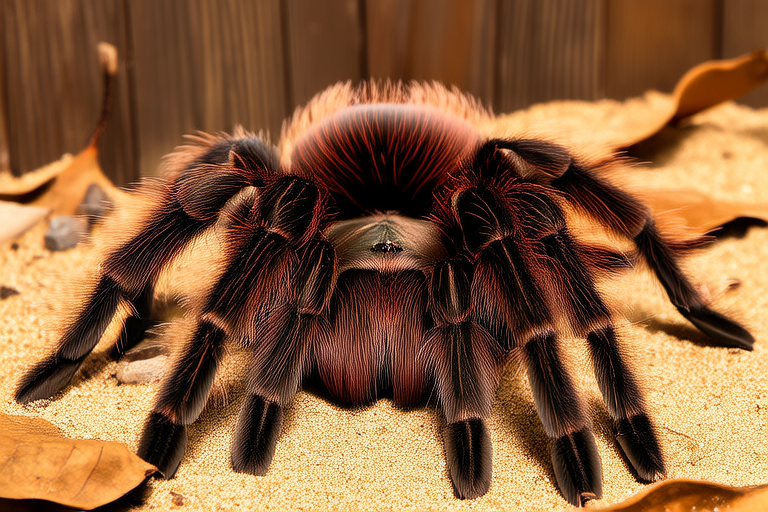A Beginner’s Guide to Handling Your Chilean Rose Tarantula Safely
Welcoming a Chilean Rose Tarantula into your home can be an exciting experience. These spiders, known for their docile nature and vibrant colors, make excellent pets for beginners. However, handling them requires care and knowledge to ensure both your safety and the spider’s well-being. This guide will walk you through the essential steps of safely handling your Chilean Rose Tarantula.
Understanding Your Tarantula
Before we delve into handling, it’s crucial to understand the behavior of your Chilean Rose Tarantula. These spiders are generally calm and docile, making them ideal for interaction. They are less likely to bite compared to other species, but they can release urticating hairs from their abdomen as a defense mechanism. These hairs can cause irritation to human skin and eyes, so always handle with caution.
Chilean Rose Tarantulas are nocturnal, meaning they are more active at night. They tend to be more relaxed during these hours, which might be a good time to handle them. Understanding their natural behaviors can help you anticipate their reactions and avoid unnecessary stress for both you and your pet.
Necessary Equipment
Handling your tarantula requires specific equipment to ensure both your safety and your pet’s comfort. Here’s what you’ll need:
- Gloves: Wear thick, soft gloves to protect your hands from urticating hairs and potential bites.
- Handling Stick or Tweezers: Use a long-handled stick or tweezers to gently guide your tarantula onto your gloved hand.
- Safe Surface: Have a soft, flat surface nearby where you can place the tarantula if needed.
- Observation: Always observe your tarantula closely before and during handling. Look for signs of stress or discomfort.
Essential Safety Tips
Handling your Chilean Rose Tarantula safely involves several precautions:
- Wash Your Hands: Before handling, thoroughly wash your hands to remove any odors or residues that might stress your tarantula.
- Use Gloves: As mentioned earlier, wearing gloves can protect you from urticating hairs and minimize the risk of accidental bites.
- Be Gentle: Handle your tarantula gently, avoiding sudden movements that could startle it.
- Avoid Direct Contact: Try not to handle your tarantula directly with bare hands to prevent irritation from urticating hairs.
- Handle During Daylight: Tarantulas are most comfortable when handled during daylight hours, as they are typically more alert and responsive then.
Proper Handling Techniques
Learning the correct way to handle your tarantula is vital for both your safety and the spider’s well-being. Follow these steps:
- Approach Calmly: Approach your tarantula slowly and calmly. Sudden movements can startle it, causing it to become defensive.
- Use a Stick or Tweezers: Gently coax your tarantula onto your gloved hand using a stick or tweezers. Avoid touching its body directly.
- Support Its Body: Once on your hand, support your tarantula’s body by gently cupping it. Do not squeeze; instead, provide a steady, gentle hold.
- Maintain a Safe Distance: Keep your tarantula away from your face and eyes. Urticating hairs can cause severe irritation if they come into contact with sensitive areas.
- Return Safely: When you’re ready to return your tarantula to its enclosure, gently place it back inside. Make sure it has landed safely and is secure.
Common Mistakes to Avoid
Handling your tarantula incorrectly can lead to stress for both you and your pet. Here are some common mistakes to avoid:
- Handling Too Frequently: Overhandling can stress your tarantula. Limit handling sessions to once a week or less.
- Squeezing or Pinching: Never squeeze or pinch your tarantula. It can damage the spider and cause it to become aggressive.
- Handling Without Gloves: Avoid handling your tarantula without gloves. Urticating hairs can irritate your skin.
- Forcing Interaction: If your tarantula shows signs of distress, such as rearing up or releasing urticating hairs, stop handling immediately.
Ensuring Your Tarantula’s Well-being
While handling your tarantula, it’s important to ensure its comfort and safety. Here are some tips:
- Monitor for Stress: Watch for signs of stress, such as increased activity or attempts to escape. If your tarantula appears stressed, end the handling session.
- Provide a Secure Environment: Make sure your tarantula’s enclosure is secure and escape-proof. A stressed tarantula is more likely to attempt to flee.
- Feed Appropriately: After handling, ensure your tarantula has access to food and water. Handling can sometimes disrupt feeding patterns.
- Give Time to Adjust: Allow your tarantula time to adjust to its new environment. Handling too soon can cause undue stress.
Care After Handling
After handling your Chilean Rose Tarantula, there are several steps you should take to ensure its well-being:
- Thorough Cleaning: Thoroughly clean your hands and any equipment used during handling. Urticating hairs can cause irritation if left on your skin.
- Monitor for Irritation: Check yourself for any signs of irritation caused by urticating hairs. If irritation occurs, wash the affected area with soap and water.
- Observe Your Tarantula: Monitor your tarantula for any signs of stress or injury. If you notice anything unusual, consult a veterinarian specializing in exotic animals.
- Provide Comfort: Ensure your tarantula has a quiet, comfortable environment to recover. Avoid handling for a few days to allow it to settle.
Conclusion
Handling your Chilean Rose Tarantula safely requires patience, care, and the right equipment. By understanding your tarantula’s behavior, following proper handling techniques, and avoiding common mistakes, you can enjoy a rewarding relationship with your pet. Remember, each tarantula is unique, so it’s important to pay attention to its individual needs and responses. With time and practice, you’ll develop a bond with your pet that brings joy and fascination to both of you.
